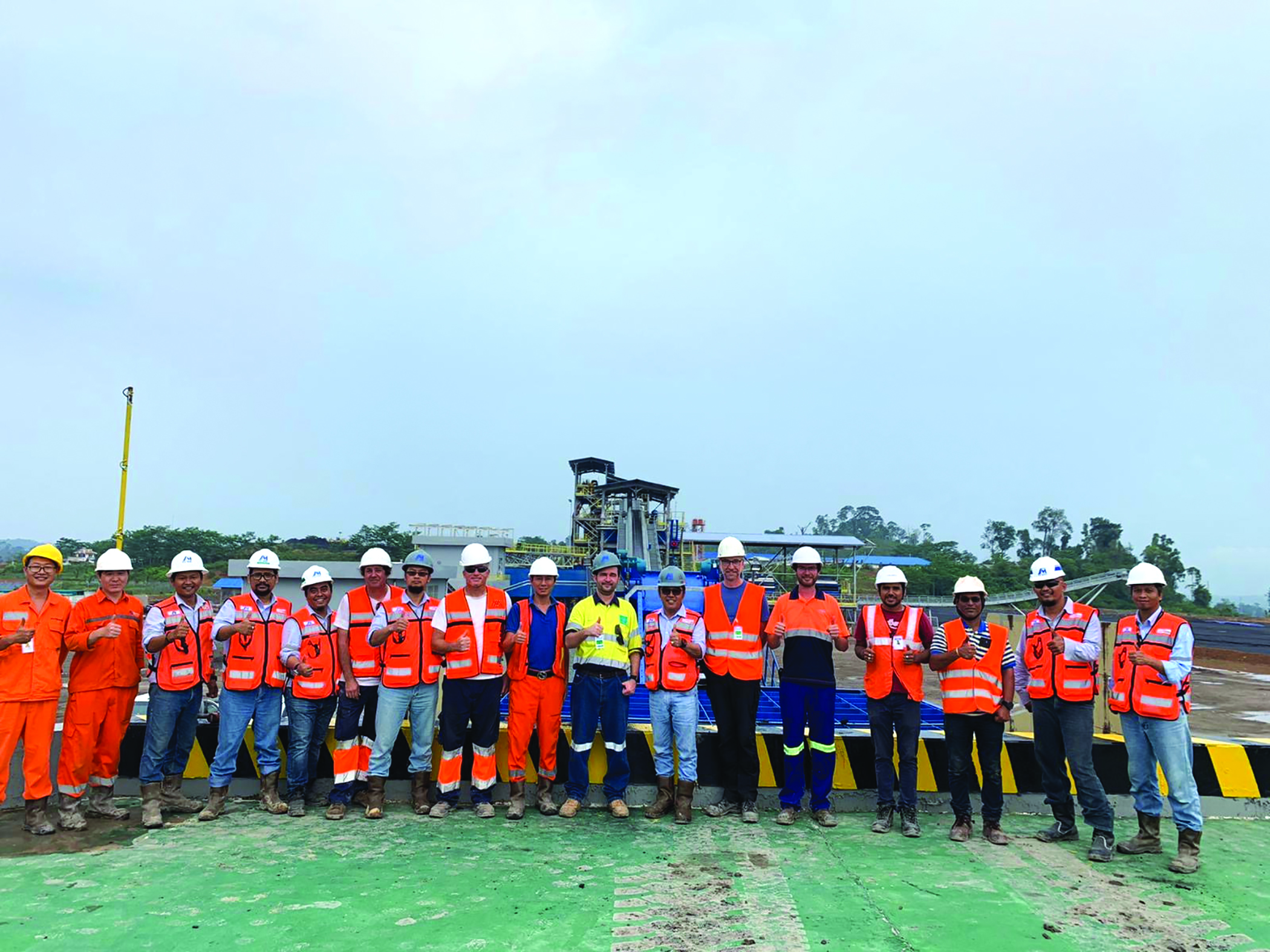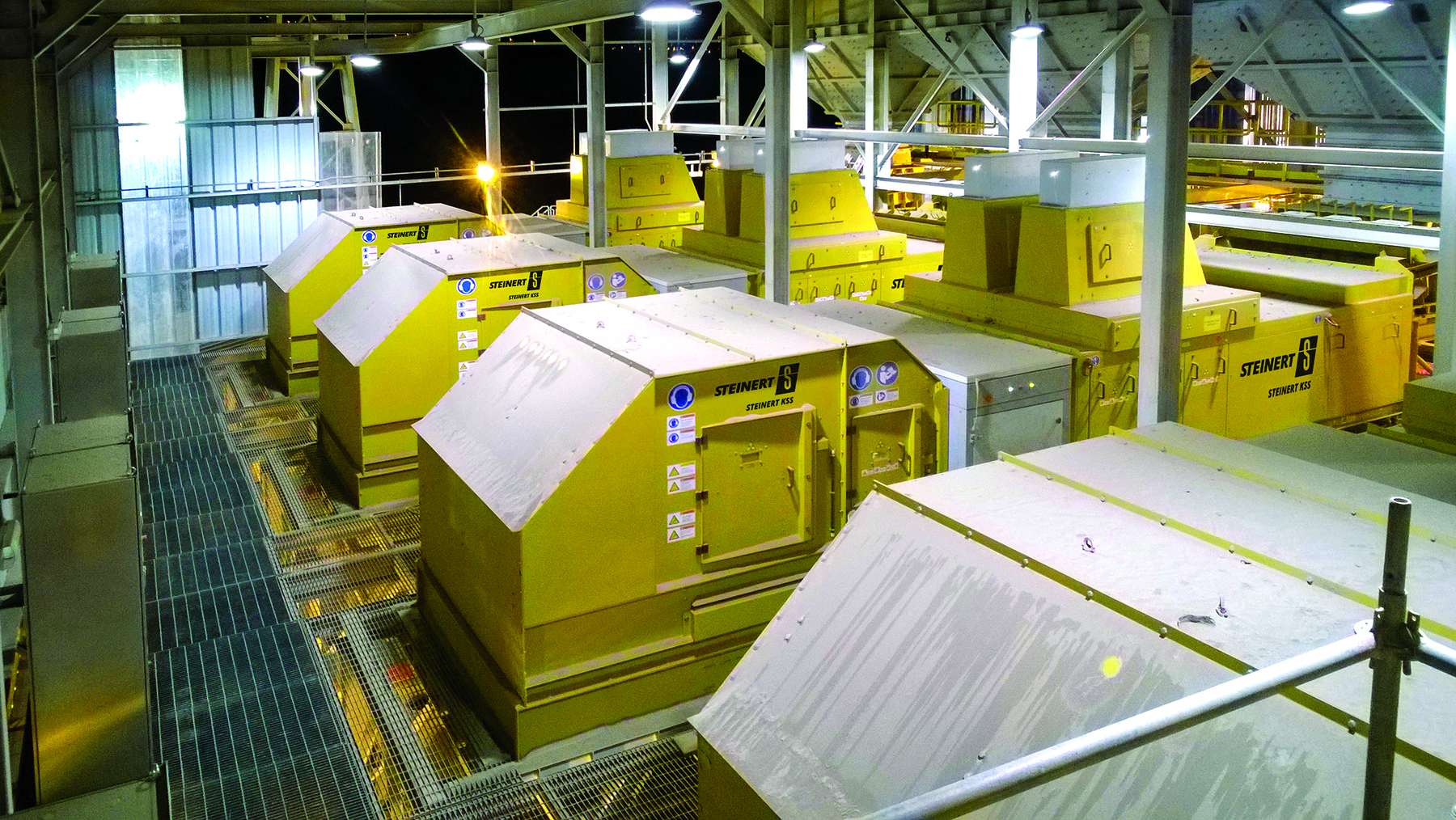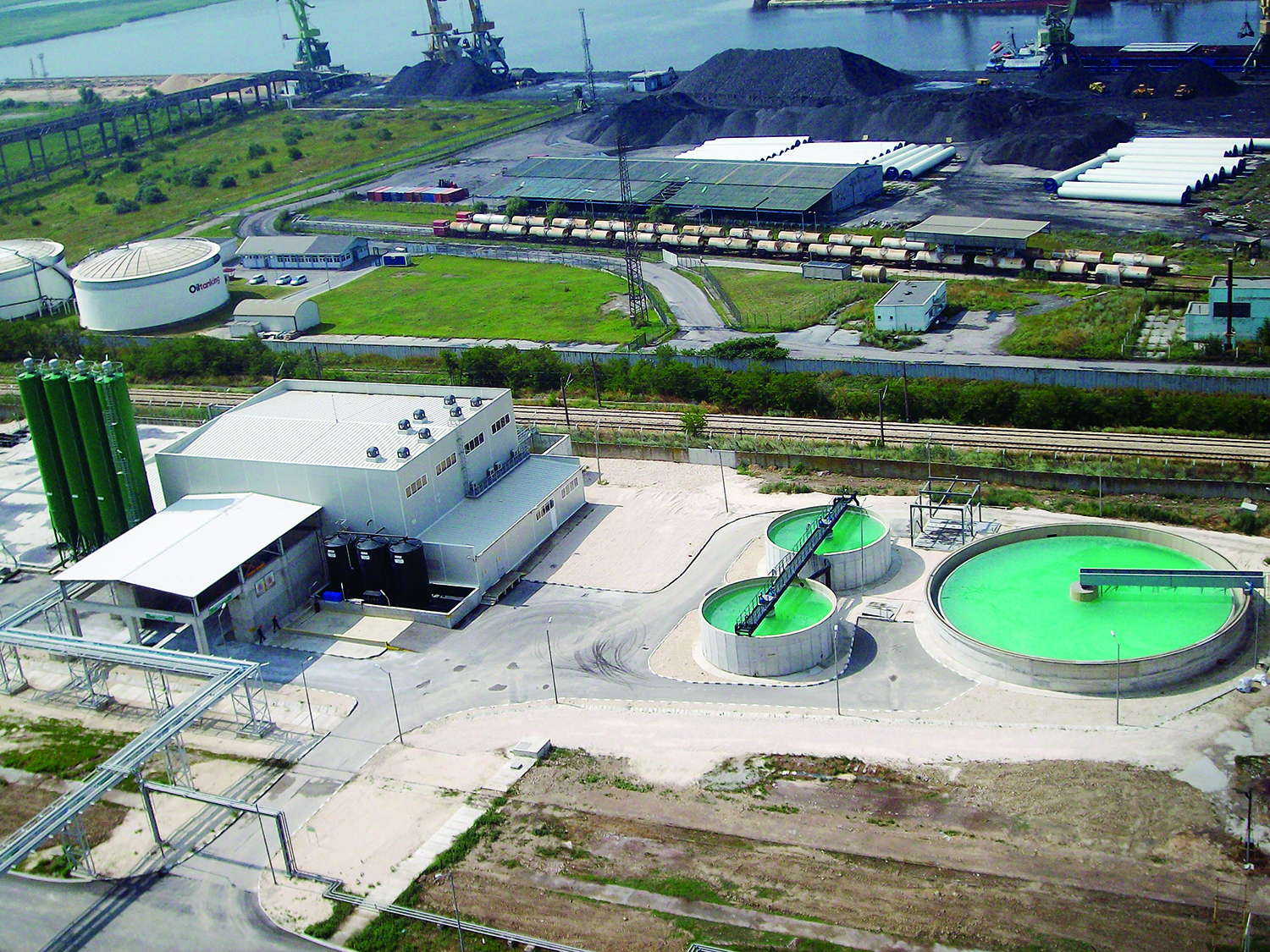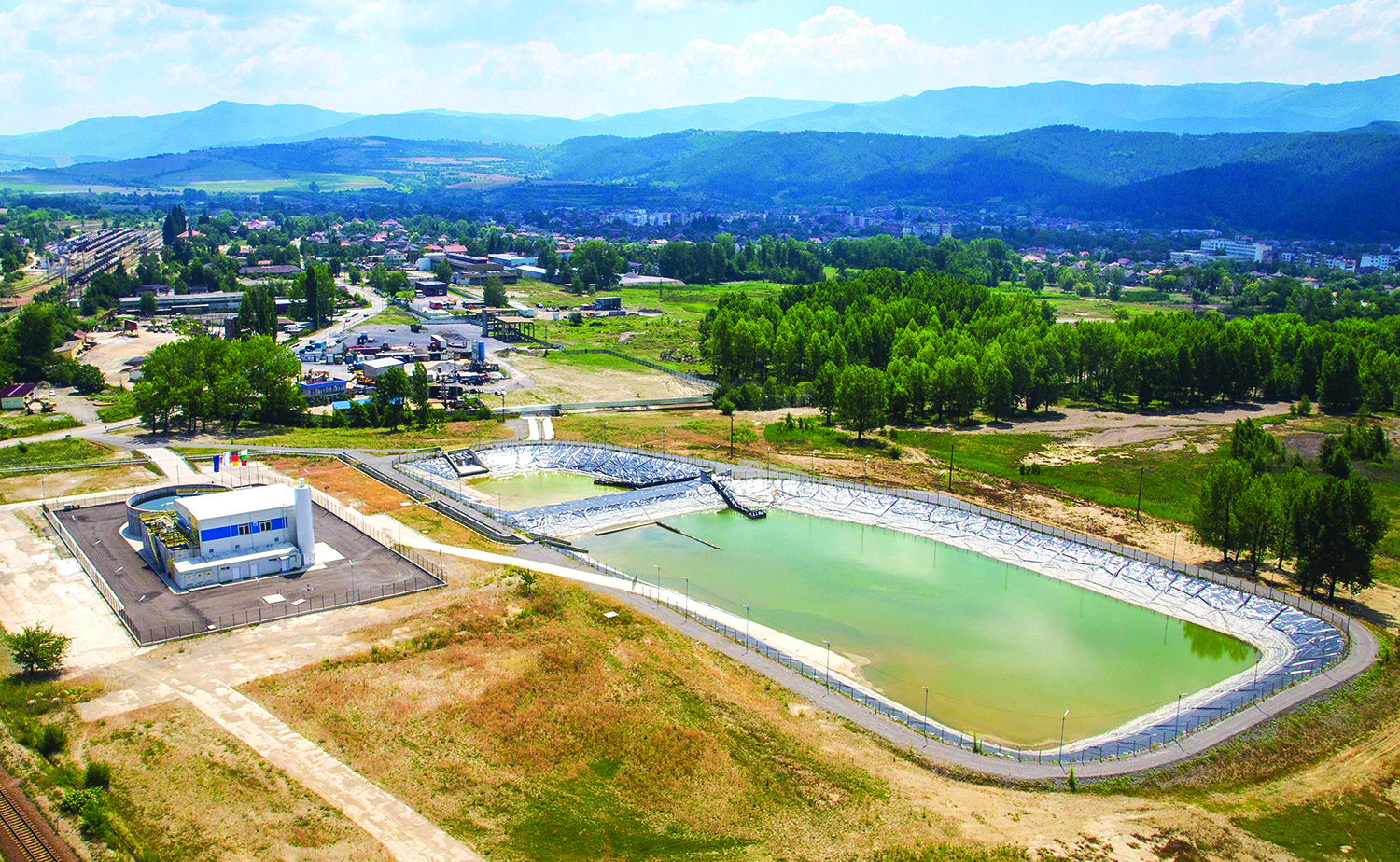Taking a more intelligent approach, new systems eliminate processing inefficiencies
As average ore grades drop, mines must process greater amounts of material to keep up with increasing demand for metals. For operations to remain economic, more effective processing and beneficiation technologies are required. This requirement is driving R&D activities across the sector and is resulting in some novel applications of existing technologies.
STEINERT Focuses on Sensor-based Sorting
In 1889, Ferdinand Steinert founded a company to recover lumps of iron from steel slag with the help of electromagnets. For decades magnetic separators and lifting magnets were the company’s main products.
In the late 1980s, the eddy current separator was added to STEINERT’s portfolio. With its unique design, the company became a worldwide leader for the separation of non-ferrous metals and, during the last 20 years, STEINERT has further developed its reputation as the specialist of choice for sensor-sorting technology.
Within the last 10 years, the X-ray transmission (XRT) technology established in the mining sector has ensured more efficient recovery processes. Separating waste rock at an early stage makes downstream processes more efficient, systems smaller, and dramatically reduces energy consumption.
For example, two STEINERT XSS T X-ray sorters are used in southern Africa to pre-concentrate sulfide gold ore into two different grain sizes. While the input material has an average gold content of less than 0.8 g/t, the sorted product achieves a concentration of more than 4 g/t with an efficiency of 90%. In this dry recovery process, the input material is reduced by more than 75% so that the rest of the procedure only has to handle concentrate. This means the recovery plant can be smaller in size while still producing the same amount of gold.

Two STEINERT XSS T X-ray sorters are used at a mine in southern Africa to pre-concentrate sulfide gold ore. (Photo: STEINERT)
XRT Technology for Sorting
In order to meet the ever-more demanding requirements and complex tasks encountered in the mining sector, STEINERT has been working to further develop its XRT technology. Through a combination of sensors, low-grade ore which would have been considered unsuitable for pre-concentration, can be detected and sorted today.
Among other sensors, the STEINERT KSS can be equipped with a laser sensor (L) in combination with XRT detection. This provides additional decision-making criteria for the classification process. Mine operators can now respond more flexibly to changed orebodies and raise or lower the cut-off grade as needed.
For instance, four STEINERT KSS units with XT L sensors, each with a working width of 2 meters, are used at a zinc, lead and silver mine in Peru to recover low-grade ore from waste dump material. Particles of between 12 mm and 35 mm diameter with a very low ore content are sorted and turned into concentrate, which can now be processed cost-effectively thanks to this sorting process. Many studies demonstrate that sorting is the best option for viably exploiting such stockpiles profitably.
Equipped with intelligently linked multi-sensors, STEINERT KSS units can be configured to optimally suit the sorting task at hand. The machine’s versatile combination of sensors gives mining companies the flexibility to respond to changes in the sorting applications.
In principle, the STEINERT KSS is a platform on which various sensors can be deployed. This includes 3D detection using lasers, color and induction recognition. The system can also be fitted with near-infrared, XRT or X-ray fluorescence (XRF) sensors. With working widths of 1 m, 2 m and 3 m, the system sorts grain sizes of 10 mm and larger.
Parallel detection of objects using several sensors and signals allows sorting tasks to be conducted, which cannot be solved with only one sensor. Several programs can be pre-set in the controller and then selected on the touch panel including:
• Color detection C
• Laser (3D) L
• Inductive sensor I
• X-ray transmission XT
• X-ray fluorescence XF
• Near-infrared NR
Making the Most of Magnetics
In addition to the successful application of sensor sorting technology, STEINERT is also a leading provider for magnetic sorting solutions for the mining industry. Its wet drum separators are widely used in coal washing plants; most of the coal leaving Australia has passed a STEINERT magnet for tramp iron removal at one of the port loading facilities, and STEINERT wet and dry drum separators are used in iron-ore beneficiation.
Most recently, STEINERT successfully used eddy current separators to sort gold nuggets from waste rock. This method goes back to an idea which Thomas Edison patented in 1889. Only with the recent developments in permanent magnets and separator designs have the repulsive forces became strong enough to separate dense gold particles.
STEINERT achieved impressive results in its test center for a new Australian deposit. Inductive sorting with a STEINERT ISS was used in addition to recover very fine gold nuggets, down to sub-millimeter sizes. A further two STEINERT ISS are also currently operating at a gold mine in South America.
At its test center in Cologne, Germany, STEINERT application specialists analyze sorting material to determine the best possible machine set-up. The sorting of all minerals, from coal and gemstones to all kind of metal ores, can be tested.

The allmineral-Astra team celebrate completion of the new coal preparation plant in Indonesia. (Photo: allmineral)
allmineral Speeds Coal Production in Kalimantan
Indonesia is the fourth most populous country in the world and the largest exporter of thermal coal globally: between 2008 and 2013, production rose from 246 million tonnes (Mt) to 489 Mt. At 90% export rate, this coal is mainly used to generate electricity in China, India and other Asian countries.
In order to meet the growing demand on the world market and maintain its pioneering position, one of the most modern coal processing units in the world was built on the island of Borneo in the newly developed mining region in Kalimantan.
The Astra Group commissioned the (at that time) Duisburg-based company allmineral, a subsidiary of Hazemag, to deliver a tailor-made coal preparation system capable of handling 500 tonnes per hour of material. The system needed to be ready by November 2019 and transported over 11,000 km to its new home.
The allmineral team impressed Astra with their comprehensive expert knowledge, extensive experience and special know-how for customized and creative solutions. In order to meet this challenge, state-of-the-art processing technology was to be used, which distinguishes and separates sub-bituminous and bituminous coal with different sulfur contents by a washing process.
An individual system solution had to be designed by the research department in the innovation center, which guarantees highest quality and durability of the coal washing plant based on the customer’s requirements. There was a tension between the high volume to be processed and the resource-saving handling.
alljig: Wet Processing at its Best
allmineral designed, manufactured, delivered and installed a coal washing system within 12 months, which relies on an alljig as its core. It is equipped with a high-performance roller crusher and a chain conveyor from Hazemag and is designed in such a way that the extracted coal is efficiently, sustainably and resource-sparingly freed from undesirable elements and sorted into different qualities. The three-chamber alljig device meticulously sorts up to 500 tonnes of coal per hour, differentiating particle sizes from 80 mm to less than 1 mm, and efficiently separating, concentrating and cleaning the coal — all fully automatically.
allmineral said the alljig F(UB) 5000 x 3400, which is both reliable and cost-effective, first loosens up the material to be processed and fluidizes it with water. During this procedure, the grains are sorted according to their density. Then the alljig separates the heavy material from the layered material bed. The concentrate is dewatered on a static filter using sensors whose signals are electronically recorded and processed.
In this way, the volume of the heavy product, which is fed into the shaker, can be precisely emptied. At the end of the third chamber the residues are emptied and dewatered and then collected in special containers.
EnviroChemie Cleans Up Mine Wastewater
Worldwide there are many abandoned underground and open-pit mines that have flooded naturally or via controlled methods. Some of these pose an ecological problem and some contain valuable residual metals that could offer economic benefits if recovered.
EnviroChemie is a leading plant engineering company that specializes in industrial water treatment, water circulation and wastewater treatment at such operations. With headquarters near Frankfurt in Germany and subsidiaries worldwide, its engineers and scientists consult on, plan, build, and maintain water treatment plants that are tailored to their respective customer’s requirements.
For copper, lead-zinc, coal and uranium mines, as well as metal, copper and phosphate fertilizer producers, EnviroChemie offers classic, centralized treatment plants, as well as modular decentralized plant systems.
These use a range of treatment methods, including oxidation, flotation, filtration, ion exchange methods for separation, and ore dressing of copper with subsequent extraction by precipitation or electrolysis; direct precipitation to hydroxide, sulphide or cementation; and membrane technologies, including combinations of ultrafiltration, nanofiltration and reverse osmosis.
EnviroChemie has plenty of experience in the erection of wastewater treatment plants for mining operations, as well as installations for the recovery of target compounds. In recent years, it has masterminded the treatment of wastewater from a famous German copper production facility, and from a leading phosphorus fertilizer production facility in Bulgaria. It has also handled wastewater treatment for three uranium mines in Germany and treated water from six coal mines belonging to the biggest coal producer in Russia.
Upon closure of the uranium mine in Eastern Germany, controlled flooding of the operation was carried out. The excess mine water contains dissolved uranium, arsenic, manganese and radium so, to allow it to be discharged safely into the local river, EnviroChemie built a water treatment plant which meets the requirements for direct discharge and radiation protection.
The wastewater treatment process is based on removal of bicarbonate, oxidation, precipitation with lime and several other reagents, flocculation, sedimentation and filtration. The resulting sludge is mechanically dewatered using a filter press, and the filter cake is then homogenized and mixed with cement to immobilize it. The immobilized product fulfills the mechanical and chemical criteria for transportation deposition, and the discharge of hazardous substances into the environment is prevented.

EIRICH’s internal test centers are available around the world for customer performance trials. (Photo: EIRICH)
EIRICH Mixers Tackle Tailings
Mixer specialist EIRICH is on a mission to clean up the mining industry’s waste dumps and, at the same time, recover valuable residual metals. The company said this makes particular sense at a time when raw materials and high-quality ore deposits are becoming increasingly scarce, and mines are striving to reduce the risk associated with their tailings facilities.
Today, high-performance mixing technology makes it possible to cost-effectively beneficiate tailings that still contain a significant level of usable minerals — even with varying moisture contents. In order to extract the minerals, the gangue materials usually need to be mixed with one or more other materials and granulated. Suitable mixing and granulation technology is required for this.
The EIRICH mixer has been in use for decades in a wide range of industries for all kinds of mixing and granulating tasks, particularly for applications demanding a high quality of mix. EIRICH said the unique working principle of this mixer normally enables advantageous process control.
Thanks to the EIRICH technology, it is possible to process materials of different types and consistencies without any problems, for example in order to produce granulates from slurries under the addition of dry materials. In the process, agglomerates are optimally disintegrated so that the end product offers an excellent quality of mix, even if auxiliary substances such as chemicals are added in the parts per million range. The self-cleaning effects and the system-related low wear of the mixer are also important aspects.
In addition to mixers that operate on a batch basis, mixers that operate continuously can also be advantageous in these applications. For example, it has been shown in the processing of tailing mounds from magnesite production that these mixers offer significant process and cost advantages. One of the advantages here is that — unlike in batch mode — there is no time needed for filling and emptying. In addition, smaller mixers with lower input power can be used.
Every mixer is specially designed for the relevant purpose. EIRICH’s internal test centers are available around the world for customer performance trials so that process parameters can be defined. EIRICH can also supply suitable rental mixers for subsequent upscaling tests, allowing the cost-effectiveness of the preparation process to be tested at a larger scale.
thyssenkrupp Kits Out Roy Hill
In December 2019, thyssenkrupp announced it had been awarded a contract to supply a new primary jaw gyratory crusher for the Roy Hill iron ore mine in Western Australia; its third gyratory crusher order destined for the Aussie market in a 12-month period.
Located 340 kilometers southeast of Port Hedland, Roy Hill is a world-class iron-ore operation with an integrated mine, rail and port facilities producing 55 million tonnes per year (Mt/y), with approval to increase to 60 Mt/y.
The new crusher is the first above ground jaw gyratory crusher to be installed in Australia. It will be designed for high performance and cost-effective operation, i.e. low servicing and maintenance costs.
Ben Suda, Head of Sales at thyssenkrupp Industrial Solutions (Australia), commented on the announcement: “We are excited and grateful for the opportunity to be supplying Roy Hill with a new primary jaw gyratory crusher. This is the third order for such machine within a short time in Australia. It shows once again the confidence our customers in the country place in crushing equipment from thyssenkrupp.”
The jaw gyratory crusher is characterized by an especially enlarged feed opening. It is normally serrated and, together with the upper part of the mantle, forms the initial crushing zone. The coarsely crushed material is then reduced to the desired product size in the crushing chamber below.
Jaw gyratory crushers can handle much bigger chunks of material than comparable gyratory crushers of the same mantle diameter and feature a higher crushing ratio, with less tendency to become clogged in the feed zone as a result of bridging.









